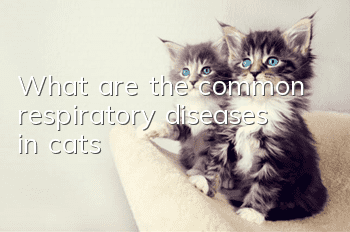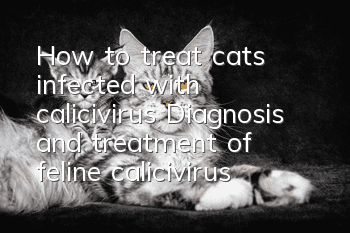What are the common respiratory diseases in cats?

Respiratory diseases are invisible and intangible, and cats cannot express their own diseases. Therefore, understanding the common respiratory diseases in cats is something every parent needs to do. There are many kinds of respiratory diseases in cats. Only after diagnosis Only then can we prescribe the right medicine. So, what are the common respiratory diseases in cats? And how are they diagnosed?
1. Common respiratory diseases in cats
1. Feline mixed respiratory disease
Mixed infection with viral infectious diseases will cause symptoms in the nasal cavity, respiratory tract, lungs, eyes and other organs. The infection routes include infection by droplets, equipment, etc. Sick cats may see sneezing, fever, runny nose, and conjunctivitis. , nasal obstruction and other symptoms. In addition to seeking medical attention as soon as possible to find out the cause of the disease, it is also very important to get vaccinated against infectious diseases such as Carisi virus and infectious rhinotracheitis on a regular basis.
2. Chronic pararhinitis
Also known as rhinopyonyus, it is often a chronic disease caused by the sequelae of viral respiratory diseases and then infected by bacteria or cryptococcus. Sick cats will often sneeze, discharge pus-like and foul-smelling nasal mucus, breathe through the mouth, lose appetite, lose weight, and even cause perforation of the bones in the accessory nasal cavity. Treatment relies on long-term medical therapy and X-ray examination to see if the nasal bones are affected.
3. Allergic bronchitis (asthma)
This disease is often seen in Siamese cats and may be caused by dust, smoke or other allergens. If chronic bronchitis is not treated, it will cause asthma. When sick cats become ill, they will have difficulty breathing, cough violently, inhale hard, scratch their mouth with their claws, and their gums and tongue will turn blue due to lack of oxygen. At this time, they need emergency treatment, otherwise they will be life-threatening and this disease is very serious. It is easy to relapse and requires long-term treatment.
4. Laryngitis
Due to bacterial or viral infection or excessive howling, it is possible to cause inflammation of the throat vocal cords, resulting in loss of voice or voice change. Generally speaking, if there are no other fever symptoms, laryngitis will recover in 5 to 7 days; if it does not improve immediately, you must seek medical treatment as soon as possible to find out the cause.
5.Flu
Influenza is a viral disease that is usually spread by contact between cats. Antibiotics have no effect on viruses, so the usual treatment method is to reduce the cat’s clinical symptoms as much as possible and improve the cat’s own resistance through nutritionally balanced food to protect the cat’s life until the cat recovers naturally. Another way to prevent it is to get vaccinated against the flu.
The symptoms of cats suffering from this disease are severe colds, and there may also be ulcers on the surface of the eyes or inside the mouth. Cats rely on their sense of smell to arouse their appetite. Influenza can cause a loss of smell, resulting in a reduction in the cat’s food intake. Some cats never recover and become chronic flu sufferers or "snuffies." Kittens are often the worst victims. Without careful care, kittens willThe cat will die. To help protect against this disease, kittens need to be vaccinated, and adult cats need an annual booster shot.
2. How to diagnose respiratory diseases in cats
The cat is put on an oxygen tube, which can receive oxygen to promote breathing. Because the cat has difficulty breathing at this time, most cats will be forced to enter the clinic for further diagnosis (such as ultrasound). X-rays are usually used at this time. If fluid is found in the chest, then the veterinarian will collect a sample of the fluid for analysis. The fluid will be analyzed for color, turbidity, protein content, and cell content. The type of fluid will indicate what kind of disease is present, such as heart failure, a tumor, infection, or chyle in the chest.
Computed tomography (CT) scans can also be used as a diagnostic tool. It can be used in situations such as when ultrasound cannot provide a diagnosis, and a CT scan can help determine whether a lung tumor can be surgically removed. If a cat is in respiratory distress due to fluid in the lungs, removing some of the fluid will provide emergency relief. The veterinarian will use a chest drain or tube for drainage, and once the cat is stable, other treatments can be used in conjunction with it.
A cat’s respiratory system is very delicate and can quickly enter a state of emergency if it becomes sick. Therefore, it is important to observe your cat's normal breathing patterns. The causes of respiratory disease in cats are also diverse, including airway obstruction, infection, parasites, allergies, asthma, heart disease, cancer, trauma, etc. These need to be diagnosed in time so that the best treatment can be adopted to ensure the health of the cat.
As parents, we are very worried about whatever disease a cat suffers from. When a cat is found to have respiratory disease, parents should actively cooperate with the doctor’s treatment, prescribe the right medicine, and stay with the cat. I believe that the cat will recover soon. Recovered.
- Can cats recover from colds on their own?
- Essential knowledge about cat psychology!
- What to do if a big cat has breast enlargement
- What’s the matter with cat’s hair turning yellow?
- Why does the blue cat keep biting its owner?
- How many hours can a kitten transported by air last?
- Which country is the Persian cat breed? Introduction to the Persian cat breed!
- Is it likely that cat ringworm is infective to humans?
- What is feline chlamydia? Symptoms and prevention methods of feline chlamydia
- How to train Persian cats differently in different scenarios?



